
Dragonets are small, percomorph, marine fish of the diverse family Callionymidae found mainly in the tropical waters of the western Indo-Pacific. They are benthic organisms, spending most of their time near the sandy bottoms, at a depth of roughly two hundred meters. There exist 139 species of the fish, in nineteen genera.
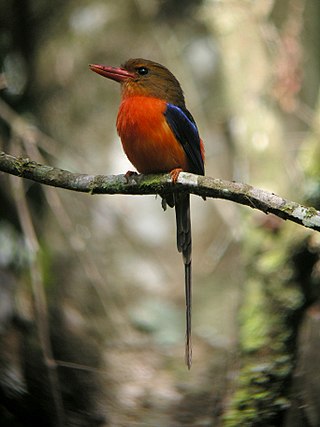
The brown-headed paradise kingfisher, also known as the russet paradise kingfisher, is a species of bird in the family Alcedinidae. It is endemic to the lowland forest in the Bird's Tail Peninsula. Its natural habitats are temperate forests and subtropical or tropical moist lowland forests. Like all paradise kingfishers this bird has colourful plumage with a red bill and distinctive long tail streamers. No subspecies are distinguished.
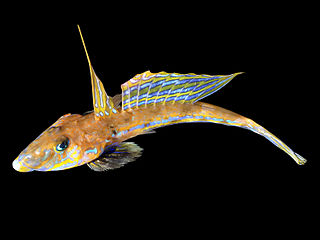
Callionymus is a genus of dragonets found mostly in the Indian and Pacific oceans with a few species occurring in the Atlantic Ocean.

The rough whiting is a dubious species of coastal marine fish in the smelt-whiting family Sillaginidae. The species is known only from the holotype which was collected in 1941 on the south coast of Papua New Guinea, but is thought to be lost. S. nierstraszi is currently a valid species, although during his revision of the sillaginids, Roland McKay suggested the species to be a senior synonym of Sillago analis.
Callionymus afilum, the Northern Australian longtail dragonet, is a species of dragonet native to the Pacific Ocean around Papua New Guinea and Australia.

The lancer dragonet, Baird's dragonet, coral dragonet or St Helena dragonet, is a species of dragonet native to the warmer waters of the Atlantic Ocean where it occurs at depths of from 1 to 91 metres. In the western Atlantic it occurs from Cape Hatteras southwards along the east coast of North America. including Bermuda and the Bahamas, into the Gulf of Mexico and throughout the Caribbean Sea. It has also been recorded from Ilha da Trindade off Brazil. In the eastern Atlantic it has been recorded from the Cape Verde Islands, Ascension Island, St. Helena, and Sao Tome e Principe in the Gulf of Guinea. This species grows to a length of 11.4 centimetres (4.5 in) TL.
Callionymus belcheri, Belcher's dragonet or the flathead dragonet, is a species of dragonet native to the Pacific Ocean waters off of Australia and Papua New Guinea where it occurs at depths of from 18 to 36 metres.
Callionymus colini, the Tiny New Guinea longtail dragonet, is a species of dragonet endemic to the Pacific Ocean waters around Papua New Guinea.
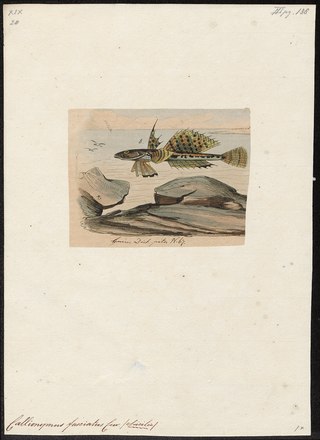
The banded dragonet is a species of dragonet native to the Mediterranean Sea from the Gulf of Genoa to the western Aegean Sea. Also known from the southern and eastern Black Sea. It prefers sandy substrates where its diet consists of benthic invertebrates.
Callionymus kailolae, Kailola's deepwater dragonet or the Northwestern ocellated dragonet, is a species of dragonet native to the Indian Ocean off of western Australia where this deep-water species is found at depths of from 200 to 204 metres. The specific name honours Patricia Kailola of Newnham, Tasmania who published a photograph of the new species, "in appreciation of her interest in callionymid fish research".
Callionymus keeleyi, Keeley's dragonet, is a species of dragonet native to the western Pacific Ocean where it is known to occur near the Philippines and Papua New Guinea. The specific name honours Frank James Keeley (1868-1949) of the department of mineralogy, Academy of Natural Sciences, Philadelphia.

The common dragonet is a species of dragonet which is widely distributed in the eastern North Atlantic where it is common near Europe from Norway and Iceland southwards. It is a demersal species that occurs over sand bottoms. It lives to a maximum age of around seven years. It is caught in bycatch by fisheries and is used in the aquarium trade.
The spotted dragonet is a species of dragonet native to the eastern Atlantic Ocean and the Mediterranean Sea where it occurs at depths of from 45 to 650 metres. This species is important to local peoples engaged in subsistence fishing.
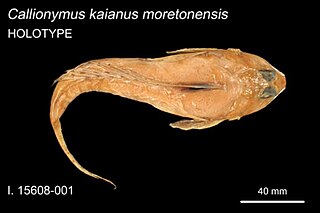
The Queensland stinkfish is a species of dragonet native to the western Pacific Ocean where it can be found in the waters off of northwestern Australia, Papua New Guinea and Melanesia. This species can be found at depths of from 124 to 132 metres. This species grows to a length of 12 centimetres (4.7 in) TL.
The long-tail dragonet is a species of dragonet native to the Pacific waters around Papua New Guinea, Indonesia and the Philippines where it occurs at depths of from 3 to 6 metres. Males of this species grows to a length of 13 centimetres (5.1 in) TL while the females are smaller.

The sailfin dragonet is a species of dragonet common in the Eastern Atlantic, where it occurs on the Portuguese coast to as far north as Lisbon and south to Morocco, and also in the northern Mediterranean including the Adriatic, Aegean and Black seas as well as the coastsLebanon and Israel. It occurs on the southern Mediterranean shore as far east as Tunisia Males of this species grows to a length of 14 centimetres (5.5 in) TL while females reach a length of 10 centimetres (3.9 in) TL. In the areas of the Mediterranean where it occurs it is one of the commonest dragonet species, as it is the only species that has been recorded within many protected areas. It is a benthic species which occurs in shallow waters and prefers sandy bottoms down to 100 metres (330 ft). The males are territorial, aggressively defend their territories from other males and like other dragonets this species undergoes complex breeding behaviour which has 4 phases. This starts with courtship, the male and female then form a pair before ascending to the surface where they release eggs and milt. The spawning season runs from May to August in the Mediterranean and the eggs and larvae are pelagic. This species feeds mainly on small benthic invertebrates such as worms and small crustaceans.
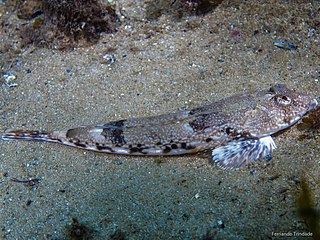
The reticulated dragonet is a species of dragonet native to the northeastern Atlantic Ocean and the Mediterranean Sea where it is found at depths of from 0 to 110 metres. This species grows to a length of 11 centimetres (4.3 in) TL. This species has a flattened head and body, the head has a triangular shape with the eyes placed on the top of the head. It has two dorsal fins with the first one being triangular in shape. It has blue spots along the flanks and four saddle-like markings on their backs which have sharply defined outlines. It is similar to the common dragonet but is distinguished by its smaller size and the sharply defined border around the saddle markings on the back.
Callionymus russelli, Russell’s dragonet, is a species of dragonet native to the Pacific waters off of Papua New Guinea.
Callionymus zythros, the Wongat dragonet, is a species of dragonet native to the Pacific waters around Papua New Guinea where it occurs at depths of from 20 to 27 metres.
The Kai Island deepwater dragonet is a species of dragonet native to the Indian Ocean and the western Pacific Ocean, from Zanzibar and the coast of East Africa to the western Pacific Ocean including southern Japan, the East China Sea and the Banda Sea. It is the only species in the monotypic genus Bathycallionymus. This species was formally described in 1880 as Callionymus kaianus by the German-born British zoologist Albert Günther with from a type collected off Kai Island in the Banda Sea during the Challenger expedition of 1872–1876. Some authorities still place this fish in the genus Callionymus.







